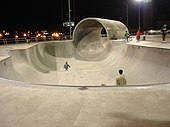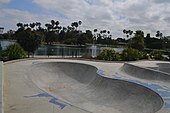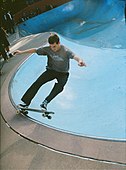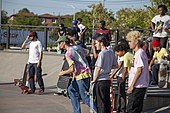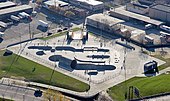United States
Alabama
- City Walk Skatepark (2022), Birmingham, Alabama. Largest skatepark in the Southeastern United States and the fifth largest skatepark in the United States. More than 57,000 square feet (5,300 m2). This skatepark is apart if the Birmingham's City Walk that spans more than 10 blocks and over 31 acres.
Arizona
- Surf City (1965), Tucson, Arizona. Asserted to be first skatepark in the world[5] Operated by Arizona Surf City Enterprises, Inc., it had concrete ramps.[6]
California
- Carlsbad Skatepark (1976), Carlsbad. California's first skatepark. Home of World Skateboard Championships on April 10, 1977. Operated until 1979, then buried, then destroyed in 2005.[5] The current Carlsbad Skatepark is elsewhere.[7]
- Pier Avenue Junior High School skatepark (1999), Hermosa Beach. Opened by the city, a small skatepark at the site of the first skateboard competition, which was organized by Dewey Weber across the street from his surf and skateboard shop. Makaha Skateboards was a sponsor of the competition.[8] School is now a museum.
- etnies Skatepark, Lake Forest – Largest free skatepark in California.[9] 62,000 square feet (5,800 m2).
- Pacifica Skatepark – Pacifica, San Francisco Bay Area. Built after consultation with Tony Hawk.
- Pedlow Skate Park – Encino, California great for pool skating, more than 12,000 square feet (1,100 m2).
- Santa Maria Skate Park – Fletcher Park. 700 Southside Pkwy, Santa Maria, California.
- The Palm Springs Skatepark contains a replica of the Nude Bowl, which is the most popular feature in the park.[10]
Connecticut
- CT Bike (1987), Bristol, Connecticut. All wooden indoor skate park, still in business today, despite a 1988 fire, operated by same family. Where Tony Hawk "made his debut when he was just a young boy on his first East Coast tour."
Florida
- Kona Skatepark in Jacksonville, Florida. One of few private parks of the 1970s surviving.[11]
- Bro Bowl – One of the last skateparks of the 70s, and one of the oldest skateparks in the U.S.; First public skatepark in Florida Tampa, Florida. Listed on the National Register of Historic Places
- Possum Creek – Gainesville, Florida.
- Skatepark of Tampa – Skatepark in Tampa and home of the annual Tampa Pro.
Iowa
- Davenport Skatepark – Davenport, Iowa.
- Lauridsen Skatepark http://www.dsmskatepark.com – Des Moines, Iowa. The largest skatepark in the United States at 88,000 square feet. (8175 square meters)
- Knoxville Skatepark - 502 N Lincoln Street, Knoxville, Iowa 50138
Kentucky
Maryland
- Ocean Bowl Skate Park (1976), Ocean City, Maryland, first on East Coast, and oldest operating municipal skate park in the United States. Renovated/rebuilt in 1997–98.[12]
New Mexico
- Alamosa Skatepark Environment, Albuquerque, New Mexico.
New York
|
Main article: Skateparks in New York City |
Ohio
- Skatopia – Anarchist Skatepark in Rutland, Ohio
- The Flow Skatepark (2001-2013), Columbus. Was a world-famous[1] skatepark. At approximately 50,000 square feet (4,600 m2), The Flow was one of the largest indoor skateparks in the nation. It was voted #1 skatepark in the United States by Fuel TV.

Oregon
- Burnside Skatepark, a do it yourself "barge build" beneath the Burnside Bridge in Portland, Oregon. The modern skatepark designs of the Pacific Northwest can be traced back to this. Skateboarders used an area populated primarily by the city's "undesirable elements" to create a skatepark, building one section at a time. The process is called "design/build" (D/B), and is a characteristic of many skateparks today. The design/build process ensures that adjacent skatepark features are harmonious and rideable, allowing skateboarders to create endless "lines" to ride among the many features. It Was featured in Tony Hawk video games and the movie Paranoid Park.
- Ashland Skate Park (1999[13]), Ashland. It's a "rad and versatile" park.[13] It was amidst some contention about families and surveillance cameras in 2018.[14]
Pennsylvania
Tennessee
- Concrete Wave Country – Nashville's first public skatepark.
Texas
- Lee and Joe Jamail Skatepark – 30,000-square-foot (2,800 m2) in-ground public facility in Houston, Texas.
Virginia
|
Main article: Skateparks in Virginia |
8 Mount Trashmore Skatepark, in Virginia Beach (24,000 square feet (2,200 m2))
Washington
- Edge Skatepark – Redmond, Washington
- A skatepark (1966), Kelso, Washington. For skateboarders and skaters, with plywood ramps, lighted for night use.[15]
Wisconsin
- Turf Skatepark (1979), Milwaukee. Included five concrete pools in an indoor/outdoor facility (defunct since 1996).
- to be processed
In more extreme climates, parks were built indoors, often using wood or metal. By the end of the 1970s, the popularity of skateboarding had waned, and the original parks of the era began to close. A downturn in the overall skateboard market in the 1980s, coupled with high liability insurance premiums, contributed to the demise of the first wave of skateparks. Some second-generation parks, such as Upland, California's Pipeline, survived into the 1980s. However, many public parks of that era can still be found throughout Western Europe, Australia and New Zealand.[citation needed]


